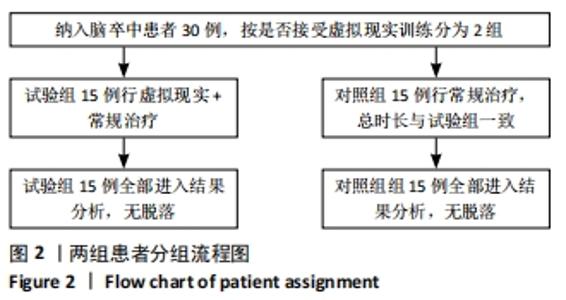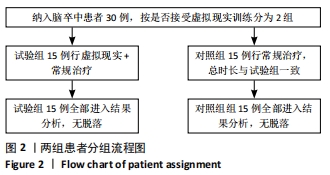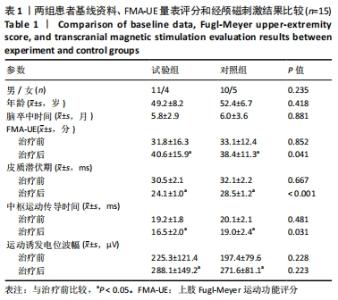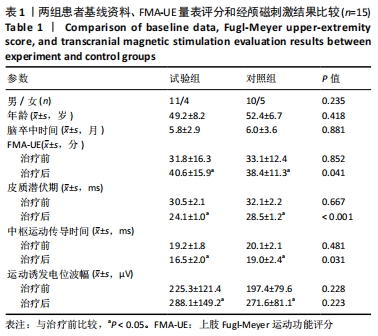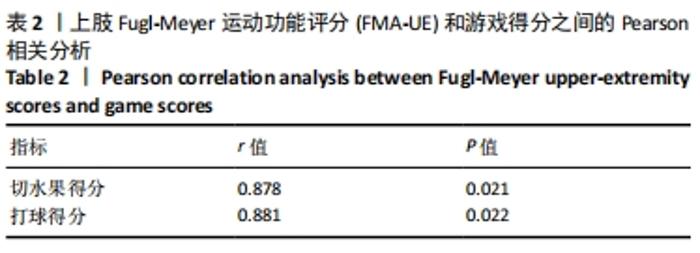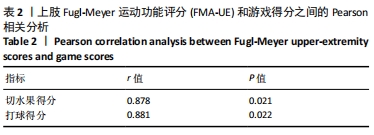Chinese Journal of Tissue Engineering Research ›› 2022, Vol. 26 ›› Issue (17): 2756-2761.doi: 10.12307/2022.547
Previous Articles Next Articles
Virtual reality training improves motor function of the upper limbs in stroke survivors: an evaluation using transcranial magnetic stimulation
Xiao Xiang1, Huang Dongfeng2
- 1Department of Rehabilitation Medicine, Luohu People’s Hospital, Shenzhen 518001, Guangdong Province, China; 2Department of Rehabilitation Medicine, Xinhua College, Sun Yat-sen University, Guangzhou 510520, Guangdong Province, China
-
Received:2021-05-06Revised:2021-06-24Accepted:2021-11-20Online:2022-06-18Published:2021-12-27 -
About author:Xiao Xiang, MD, Associate chief physician, Department of Rehabilitation Medicine, Luohu People’s Hospital, Shenzhen 518001, Guangdong Province, China -
Supported by:the 2019 Teaching Reform Research Project of Guangdong Provincial Clinical Teaching Base, No. 2019JD116 (to XX)
CLC Number:
Cite this article
Xiao Xiang, Huang Dongfeng. Virtual reality training improves motor function of the upper limbs in stroke survivors: an evaluation using transcranial magnetic stimulation[J]. Chinese Journal of Tissue Engineering Research, 2022, 26(17): 2756-2761.
share this article
Add to citation manager EndNote|Reference Manager|ProCite|BibTeX|RefWorks
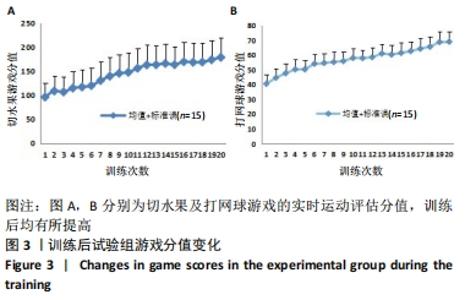
2.4 临床量表和经颅磁刺激结果 见表1。 两组患者训练前的FMA-UE相比差异无显著性意义(P > 0.05);训练后两组患者的FMA-UE均较训练前显著提高(P < 0.05),且试验组较对照组FMA-UE提高幅度更大(P < 0.05)。 两组患者训练前MEP的皮质潜伏期、中枢运动传导时间和波幅相比差异无显著性意义(P > 0.05);训练后两组患者的MEP的波幅均较训练前显著增大(P < 0.05),MEP的皮质潜伏期、中枢运动传导时间均较训练前显著缩短(P < 0.05),且试验组较对照组MEP的皮质潜伏期和中枢运动传导时间缩短幅度更大(P < 0.05),但两组间的波幅相比差异无显著性意义(P > 0.05)。 2.5 游戏指标分值 试验组所有患者切水果、打网球游戏的实时运动评估分值在训练后均有提高,见图3。"
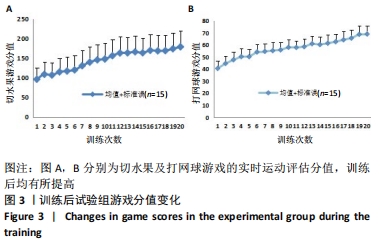
| [1] GONÇALVES MG, PIVA MFL, MARQUES CLS, et al. Effects of virtual reality therapy on upper limb function after stroke and the role of neuroimaging as a predictor of a better response. Arq Neuropsiquiatr. 2018;76(10):654-662. [2] 王陇德,刘建民,杨弋,等. 我国脑卒中防治仍面临巨大挑战——《中国脑卒中防治报告2018》概要[J]. 中国循环杂志,2019,34(2):105-119. [3] ZHENG Y, PENG Y, XU G, et al. Using corticomuscular coherence to reflect function recovery of paretic upper limb after stroke: a case study. Front Neurol. 2018;8:728. [4] LEE MM, LEE KJ, SONG CH. Game-based virtual reality canoe paddling training to improve postural balance and upper extremity function: a preliminary randomized controlled study of 30 patients with subacute stroke Med Sci Monit. 2018;24:2590-2598. [5] BORREGO A, LATORRE J, ALCAÑIZ M, et al. Embodiment and presence in virtual reality after stroke. A comparative study with healthy subjects. Front Neurol. 2019;10;10:1061. [6] 肖湘,梁斌. 虚拟现实训练对脑卒中恢复期患者认知功能和P300的影响[J]. 中国康复医学杂志,2019,34(3):339-341. [7] 肖湘,黄东锋,梁斌.虚拟现实训练对亚急性期脑卒中患者上肢运动功能的影响[J]. 中国康复医学杂志,2019,34(9):1049-1053. [8] STOCKLEY R, O’CONNOR D, SMITH P, et al. A mixed methods small pilot study to describe the effects of upper limb training using a virtual reality gaming system in people with chronic stroke. Rehabil Res Pract. 2017;2017:9569178. [9] BRUNNER I, SKOUEN J S, HOFSTAD H, et al. Virtual reality training for upper extremity in subacute stroke (VIRTUES): study protocol for a randomized controlled multicenter trial. BMC Neurol. 2014;14(1):1-5. [10] PLACIDI G, CINQUE L, POLSINELLI M, et al. Measurements by a LEAP-based virtual glove for the hand rehabilitation. Sensors (Basel). 2018;18(3):834. [11] XIAO X, LIN Q, LO WL, et al. Cerebral reorganization in subacute stroke survivors after virtual reality-based training: a preliminary study. Behav Neurol. 2017;2017:6261479. [12] RUSSO M, DE LUCA R, NARO A, et al. Does body shadow improve the efficacy of virtual reality-based training with BTS NIRVANA?: a pilot study. Medicine (Baltimore). 2017;96(38):e8096. [13] WANG ZR, WANG P, XING L, et al. Leap motion-based virtual reality training for improving motor functional recovery of upper limbs and neural reorganization in subacute stroke patients. Neural Regen Res. 2017;12(11):1823-1831. [14] TIERI G, MORONE G, PAOLUCCI S, et al. Virtual reality in cognitive and motor rehabilitation: facts, fiction and fallacies. Exp Rev Med Dev. 2018;15(2):107-117. [15] PATEL J, FLUET G, QIU Q, et al. Intensive virtual reality and robotic based upper limb training compared to usual care, and associated cortical reorganization, in the acute and early sub-acute periods post-stroke: a feasibility study. J Neuroeng Rehabil. 2019;16(1):92. [16] 金信浩,郑兵,吴雪莲,等. 丰富环境对脑卒中患者神经功能康复的效果[J]. 中国康复理论与实践,2017,23(3):323-325. [17] 蔡春,张运亮.运动改善大脑执行功能机制的研究进展[J]. 成都体育学院学报,2019,45(6):120-126. [18] FISICARO F, LANZA G, GRASSO AA, et al. Repetitive transcranial magnetic stimulation in stroke rehabilitation: review of the current evidence and pitfalls. Ther Adv Neurol Disord. 2019;25;12:1756286419878317. [19] PEREZ-MARCOS D. Virtual reality experiences, embodiment, videogames and their dimensions in neurorehabilitation. J Neuroeng Rehabil. 2018;15(1):113. [20] 苏敏, 韩立影, 杨卫新, 等. 经颅磁刺激在脑卒中患者上肢功能康复疗效评估中的应用[J]. 中华物理医学与康复杂志,2016,38(3):175-179. [21] MCDONNELL MN, STINEAR CM. TMS measures of motor cortex function after stroke: A meta-analysis. Brain Stimul. 2017;10(4):721-734. [22] KUBIS N. Non-invasive brain stimulation to enhance post-stroke recovery. Front Neural Circuits. 2016;10:56. [23] TOSUN A, TÜRE S, ASKIN A, et al. Effects of low-frequency repetitive transcranial magnetic stimulation and neuromuscular electrical stimulation on upper extremity motor recovery in the early period after stroke: a preliminary study. Top Stroke Rehabil. 2017;24(5):361-367. [24] KUO IJ, TANG CW, TSAI YA, et al. Neurophysiological signatures of hand motor response to dual-transcranial direct current stimulation in subacute stroke: a TMS and MEG study. J Neuroeng Rehabil. 2020; 17(1):72. [25] VAN LIESHOUT EC, JACOBS LD, PELSMA M, et al. Exploring the experiences of stroke patients treated with transcranial magnetic stimulation for upper limb recovery: a qualitative study. BMC Neurol. 2020;20(1):365. [26] SUMMERS JJ, KAGERER FA, GARRY MI, et al. Bilateral and unilateral movement training on upper limb function in chronic stroke patients: A TMS study. J Neurol Sci. 2007;252(1):76-82. [27] HORDACRE B, GHOSH R, GOLDSWORTHY MR, et al. Transcranial magnetic stimulation-EEG biomarkers of poststroke upper-limb motor function. J Stroke Cerebrovasc Dis. 2019;28(12):104452. [28] AURIAT AM, NEVA JL, PETERS S, et al. A review of transcranial magnetic stimulation and multimodal neuroimaging to characterize post-stroke neuroplasticity. Front Neurol. 2015;6:226. [29] NEVA JL, BROWN KE, WADDEN KP, et al. The effects of five sessions of continuous theta burst stimulation over contralesional sensorimotor cortex paired with paretic skilled motor practice in people with chronic stroke. Restor Neurol Neurosci. 2019;37(3):273-290. [30] GUO Z, JIN Y, BAI X, et al. Distinction of high- and low-frequency repetitive transcranial magnetic stimulation on the functional reorganization of the motor network in stroke patients. Neural Plast. 2021:8873221. [31] YUAN X, YANG Y, CAO N, et al. Promotion of poststroke motor-function recovery with repetitive transcranial magnetic stimulation by regulating the interhemispheric imbalance. Brain Sci. 2020;10(9):648. [32] DU J, YANG F, HU J, et al. Effects of high- and low-frequency repetitive transcranial magnetic stimulation on motor recovery in early stroke patients: Evidence from a randomized controlled trial with clinical, neurophysiological and functional imaging assessments. Neuroimag Clin. 2019;21:101620. [33] 曾明,沈芳,朱美红,等. 动作观察疗法对恢复期脑梗死患者上肢运动功能及运动诱发电位的影响[J]. 中国康复医学杂志,2018, 33(4):419-423. [34] 中华医学会神经病学分会,中华医学会神经病学分会脑血管病学组. 中国各类主要脑血管病诊断要点2019[J]. 中华神经科杂志, 2019,52(9):710-715. [35] MERIANS AS, TUNIK E, ADAMOVICH SV. Virtual reality to maximize function for hand and arm rehabilitation: exploration of neural mechanisms. Stud Health Technol Inform. 2009;145:109-125. [36] Tsoupikova D, Stoykov NS, Corrigan M, et al. Virtual immersion for post-stroke hand rehabilitation therapy. Annals of biomedical engineering. 2015;43(2):467 -477. [37] HUO CC, ZHENG Y, LU WW, et al. Prospects for intelligent rehabilitation techniques to treat motor dysfunction. Neural Regen Res. 2021;16(2): 264-269. [38] 郑海清,胡昔权,方杰,等. 运动训练对脑梗死大鼠梗死边缘区突触可塑性的影响[J]. 中华医学杂志,2012,29(9):628-633. [39] MAGGIO MG, LATELLA D, MARESCA G, et al. Virtual reality and cognitive rehabilitation in people with stroke: an overview. J Neurosci Nurs. 2019;51(2):101 -105. [40] SAPOSNIK G, COHEN LG, MAMDANI M, et al. Efficacy and safety of non-immersive virtual reality exercising in stroke rehabilitation (EVREST): a randomised, multicentre, single-blind, controlled trial. Lancet Neurol. 2016;15(10):1019-1027. [41] BEAULIEU LD, MILOT MH. Changes in transcranial magnetic stimulation outcome measures in response to upper-limb physical training in stroke: A systematic review of randomized controlled trials. Ann Phys Rehabil Med. 2018;(61):224-234. |
| [1] | Zhao Jing, Liu Xiaobo, Zhang Yue, Zhang Jiaming, Zhong Dongling, Li Juan, Jin Rongjiang. Visualization analysis of neuromuscular electrical stimulation therapy based on CiteSpace: therapeutic effects, hot spots, and developmental trends [J]. Chinese Journal of Tissue Engineering Research, 2022, 26(8): 1234-1241. |
| [2] | Tang Wenjing, Wu Siyuan, Yang Chen, Tao Xi. Inflammatory responses in post-stroke depression [J]. Chinese Journal of Tissue Engineering Research, 2022, 26(8): 1278-1285. |
| [3] | Liu Gang, Ma Chao, Wang Le, Zeng Jie, Jiao Yong, Zhao Yi, Ren Jingpei, Hu Chuanyu, Xu Lin, Mu Xiaohong. Ankle-foot orthoses improve motor function of children with cerebral palsy: a Meta-analysis based on 12 randomized controlled trials [J]. Chinese Journal of Tissue Engineering Research, 2022, 26(8): 1299-1304. |
| [4] | Fang Xiaolei, Leng Jun, Zhang Chen, Liu Huimin, Guo Wen. Systematic evaluation of different therapeutic effects of mesenchymal stem cell transplantation in the treatment of ischemic stroke [J]. Chinese Journal of Tissue Engineering Research, 2022, 26(7): 1085-1092. |
| [5] | Shan Sharui, Huang Xuming, Zhang Mingxing, Wang Xiukun, Zheng Xiang, Bao Sairong, Hong Feng. Three-dimensional gait analysis of low-frequency repetitive transcranial magnetic stimulation for post-stroke hemiplegia [J]. Chinese Journal of Tissue Engineering Research, 2022, 26(5): 762-767. |
| [6] | Lu Qinxue, Xu Ning, Yang Yinglan, Han Qianqian, Duanmu Xianyu, Guo Yuwei, Han Qing. Femoroacetabular impingement: strength trainings for nerve-muscle, peripheral muscle and core muscle [J]. Chinese Journal of Tissue Engineering Research, 2022, 26(5): 786-791. |
| [7] | Wang Chong, Zhang Meiying, Zhou Jian, Lao Kecheng. Early gait changes after total hip arthroplasty through direct anterior approach and posterolateral approach [J]. Chinese Journal of Tissue Engineering Research, 2022, 26(3): 359-364. |
| [8] | Li Shulun, Hao Peng, Hao Fei, Duan Hongmei, Zhao Wen, Gao Yudan, Yang Chaoyang, Li Xiaoguang. Pathological changes in rats with ischemic stroke induced by improved photochemical embolization [J]. Chinese Journal of Tissue Engineering Research, 2022, 26(2): 218-224. |
| [9] | Yang Yanwen, Zhang Jing, Mao Yuling, Ni Jun, Mao Libin, Yao Lu, Wang Huiying, Liu Qiuming, Ma Zhenzhen. Establishment of a severe heatstroke pig model under high-temperature and high-humidity environment [J]. Chinese Journal of Tissue Engineering Research, 2022, 26(17): 2678-2684. |
| [10] | Wang Yongchao, Wang Baochen, Wei Zhuying, Bao Chunyu, Liu Shijun, Meng Qinghua. Blood flow restriction method for inducing cross-education phenomenon and muscle function reconstruction [J]. Chinese Journal of Tissue Engineering Research, 2022, 26(17): 2762-2767. |
| [11] | Xue Xiali, Deng Zhongyi, Sun Junzhi, Li Ning, Ren Wenbo, Zhou Ling, He Ye. Hot spots and frontiers of rehabilitation robot research in recent 10 years: a bibliometric analysis based on the Web of Science database [J]. Chinese Journal of Tissue Engineering Research, 2022, 26(14): 2214-2222. |
| [12] | Chen Na, Fan Feiyan, Li Shuangli, Zhang Yunke. Effect and mechanism of traditional Chinese medicine regulating mesenchymal stem cell-derived exocrine for ischemic stroke [J]. Chinese Journal of Tissue Engineering Research, 2022, 26(13): 2081-2086. |
| [13] | Yu Basuo, Sun Mingyun, Yang Hongmei, Bao Yaling, Qian Zhenyu, Meng Haijiang, Zhou Duoqi. Characteristics and influencing factors of carotid blood flow in younger adults in different body positions [J]. Chinese Journal of Tissue Engineering Research, 2022, 26(11): 1734-1740. |
| [14] | Lü Shuaiyao, Guan Haishan, Hao Chen, Ding Zhuangzhi. Cervical spondylotic amyotrophy: problems about classification, diagnosis, treatment, and prognosis [J]. Chinese Journal of Tissue Engineering Research, 2022, 26(11): 1788-1792. |
| [15] | Mei Yunyun, Zhang Jianjun, Wang Dong. Hyperbaric oxygen combined with NgR gene silencing bone marrow mesenchymal stem cells transplantation for spinal cord injury in rats [J]. Chinese Journal of Tissue Engineering Research, 2022, 26(1): 12-19. |
| Viewed | ||||||
|
Full text |
|
|||||
|
Abstract |
|
|||||
